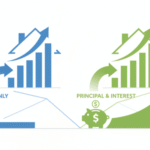You’re sitting across from your mortgage broker, and they ask the question: “Fixed or variable?”
If you’re like most Queensland homeowners right now, you probably need a moment to think. It’s an important decision, and with the Reserve Bank making rate changes throughout 2025, understanding your options matters more than ever.
Here’s what I want you to know: there’s no universally “right” answer, but there IS information that can help you make an informed choice. And after reading this, you’ll actually understand what you’re choosing between.
What’s Currently Happening with Interest Rates?
Let me give you the current state of play because context matters.
The RBA cash rate is sitting at 3.60% as of October 2025, following three consecutive cuts of 0.25% each in February, May, and August. That’s had a real impact on borrowers’ repayments.
According to recent commentary from major banks and economic analysts, further adjustments may be possible, with some forecasts suggesting the cash rate could move to around 3.35% by December 2025. However, economic forecasts are subject to change based on inflation, employment data, and global economic conditions.
Currently, the average home loan interest rate for owner-occupiers sits at 5.76% per annum, with competitive rates available from around 4.64% for fixed loans and 4.99% for variable loans as of October 2025. These rates vary significantly between lenders and depend on individual circumstances.
Important note: Interest rates and economic conditions change regularly. The information in this article reflects data available in October 2025 and should not be relied upon as current at a later date.
Variable Rate Home Loans: Understanding the Flexibility
Think of a variable rate loan as having a direct connection to market movements. The rate adjusts based on economic conditions.
A variable rate home loan has an interest rate that fluctuates with market conditions, typically moving in response to changes in the RBA cash rate. When the RBA adjusts rates, lenders may pass on changes to borrowers, though they’re not obligated to pass on the full adjustment amount or do so immediately.
🏠 Fixed vs Variable Loan Comparison Tool
Compare potential costs between fixed and variable rate loans based on your circumstances
💚 Variable Rate Loan
🔒 Fixed Rate Loan
Key Features of Variable Loans
Repayment flexibility is a significant feature. Variable loans typically allow unlimited extra repayments without penalty, which means additional funds like tax refunds or bonuses can be applied directly to the loan principal. This can potentially reduce the total interest paid over the life of the loan.
For context, a borrower with a $600,000 mortgage would have seen their monthly repayments reduce by approximately $272 following the three rate cuts in 2025. This figure is illustrative only and actual savings depend on your specific loan terms, lender, and how rate changes are passed on.
Offset accounts are commonly available. Most variable loans include them. An offset account works like a regular transaction account but is linked to your home loan—any balance in your offset account reduces the amount on which you pay interest.
For example: With a $400,000 loan and $20,000 in an offset account, you pay interest on $380,000. The $20,000 could be your emergency fund or everyday savings, working to reduce your interest without being locked away.
Redraw facilities are another common feature—they allow you to access extra repayments you've made above the minimum required amount. This can provide financial flexibility for unexpected expenses, though access conditions vary between lenders.
Lower exit costs. Variable loans typically don't charge break fees if you need to refinance, sell your property, or switch loan products, providing more flexibility to adapt to changing circumstances.
Need to figure out how much you can borrow? Our borrowing capacity guide explains the factors lenders consider.
Considerations with Variable Loans
The main consideration is rate uncertainty. If interest rates increase, your repayments will also increase, which could impact your budget. While current economic commentary suggests rates may ease further, this is not guaranteed.
The fluctuating nature of variable rates can make long-term budgeting more complex, particularly if you prefer certainty in your monthly expenses.
Fixed Rate Home Loans: Understanding the Stability
A fixed rate loan locks in your interest rate for a set period, typically between one and five years. Your repayments remain constant during that time, regardless of market movements.
Key Features of Fixed Loans
Repayment certainty is the primary benefit. You know exactly what your repayments will be throughout the fixed period, which can simplify budgeting and financial planning.
Protection from rate increases. If interest rates rise during your fixed term, your repayments remain unchanged. In previous rising rate environments (such as 2022-2023), borrowers with fixed rates were insulated from multiple rate increases.
At present, some fixed rates are lower than comparable variable rates. Following the RBA adjustments, fixed rates for terms under three years have reduced by approximately 0.70% for owner-occupiers. Rates in the high 4% range are available from some lenders, compared to variable rates in the mid-5% range, though individual circumstances affect the rates offered to you.
Considerations with Fixed Loans
Fixed loans typically have limitations on extra repayments—most lenders allow only around $10,000 per year in additional repayments without penalty. Beyond this, you may incur fees.
Offset accounts and redraw facilities are generally not available during the fixed period, or may be restricted.
Break costs can be substantial. If you need to exit your fixed loan early—whether to refinance, sell your property, or make large additional repayments—you may face break fees. As an illustrative example, breaking a 5-year fixed loan after 2 years when rates have fallen significantly could result in break fees of $15,000 or more on a $300,000 loan. Actual break costs depend on interest rate movements, remaining loan term, and lender calculations.
If rates decrease during your fixed period, you won't benefit from those reductions until your fixed term ends, at which point your loan typically reverts to the lender's standard variable rate.
For first-time buyers managing tight budgets, understanding these trade-offs is important. Our guide on common mistakes first-time buyers should avoid provides additional context.

What Are Queensland Borrowers Currently Choosing?
Market data provides interesting context. In August 2024, approximately 98% of new home loans were variable, while only 2% were fixed. This contrasts significantly with August 2021, when 46% of borrowers chose fixed rates during a period of historically low rates.
This shift reflects changing borrower sentiment about the interest rate environment. In 2021, with rates at historic lows, many borrowers locked in those rates anticipating increases. Current borrower behaviour suggests different expectations about rate movements.
However, market trends don't necessarily indicate what's appropriate for your individual circumstances. Your decision should be based on your specific financial situation, goals, and risk tolerance.
Split Loans: A Middle Ground Approach
A split loan divides your mortgage between fixed and variable portions. Common splits include 50:50, 70:30, or any ratio that suits your circumstances.
The fixed portion provides repayment certainty and protection from rate increases, while the variable portion allows extra repayments, offset account access, and the ability to benefit from any rate decreases. This approach can help balance certainty with flexibility.
Many Queensland borrowers are currently using split loans to manage uncertainty in the interest rate environment. The split ratio can be adjusted based on your priorities around certainty versus flexibility.
The main consideration is that managing two loan accounts can be slightly more complex administratively, and you may not receive the lowest possible rate on either portion compared to selecting one loan type entirely.
Features Beyond Fixed vs Variable
When evaluating loans, consider these additional features:
Offset accounts are typically available on variable loans, though some lenders now offer them on fixed loans too. The balance in your offset account reduces the loan balance on which you pay interest, potentially saving considerable amounts over the loan term. For borrowers who maintain savings, this feature can be more valuable than a slightly lower interest rate.
Repayment types matter significantly. Both fixed and variable loans can be principal and interest or interest-only. Principal and interest repayments reduce your loan balance over time and typically result in less total interest paid. Interest-only repayments are lower initially but don't reduce your debt.
Lenders Mortgage Insurance (LMI) applies when you borrow more than 80% of the property value, regardless of whether you choose fixed or variable. However, the expanded First Home Guarantee Scheme (as of October 2025, subject to eligibility criteria and government terms) can help Queensland buyers avoid LMI with a 5% deposit, with property price caps of $1,000,000 in Brisbane and South East Queensland, and $700,000 in regional areas. If you're a first home buyer, it's worth investigating whether you're eligible.
Making Your Decision
Your choice should be based on your individual circumstances rather than market trends or predictions. Here are frameworks to consider:
Variable loans may suit you if:
You value flexibility and want the ability to make extra repayments without restriction. You want access to an offset account to reduce interest paid. You can accommodate potential repayment increases in your budget. You prefer the flexibility to refinance or switch products without break costs.
If you're considering refinancing your current home loan to access better rates or features, variable loans provide that flexibility without exit penalties.
Fixed loans may suit you if:
You prioritize knowing your exact repayments for budgeting purposes. Your budget has limited capacity to absorb repayment increases. You're not planning to make significant extra repayments. Current fixed rates are competitive compared to variable rates.
Split loans may suit you if:
You want some certainty while maintaining access to features like offset accounts. You want to make some extra repayments while having portion of your loan protected. You prefer not to commit entirely to one loan type given market uncertainty.
Important Considerations
The information presented here is general in nature and reflects market conditions as of October 2025. Interest rates, lending criteria, and government schemes change regularly.
Variable loans can be switched to fixed (or vice versa) as your circumstances change, and when fixed terms end, you can reassess and choose a new strategy.
A loan with a slightly higher rate but features that suit your situation (such as offset accounts or flexible repayments) may result in less total interest paid over the life of the loan compared to the lowest available rate with no additional features.
Your best approach is to compare the total package—interest rate, fees, features, and flexibility—rather than focusing solely on the advertised rate.
Want to see how different rates and loan types affect your repayments? Use our home loan calculator to explore scenarios, or get in touch with our team to discuss your specific circumstances with a licensed mortgage broker.
Disclaimer
Important Information: The information in this article is general in nature and does not take into account your personal financial situation, needs, or objectives. All figures, examples, and rate information are provided for illustrative purposes only and were current as of October 2025. Interest rates, lending criteria, government schemes, and economic conditions change regularly.
This article does not constitute financial, legal, or credit advice. Before making any decisions about home loans or financial products, you should:
- Consider your personal circumstances and objectives
- Consult with a licensed mortgage broker or financial adviser
- Review current product disclosure statements and terms
- Verify current interest rates and eligibility criteria with lenders
Economic forecasts and predictions referenced in this article are based on third-party sources and are subject to change. Past performance and current trends are not reliable indicators of future outcomes.
For specific advice tailored to your situation, speak with a licensed professional who can assess your individual circumstances and provide appropriate recommendations.
AJ Home Loans Gladstone operates under appropriate licensing arrangements. For licensing details and to discuss your home loan options, please contact us.



